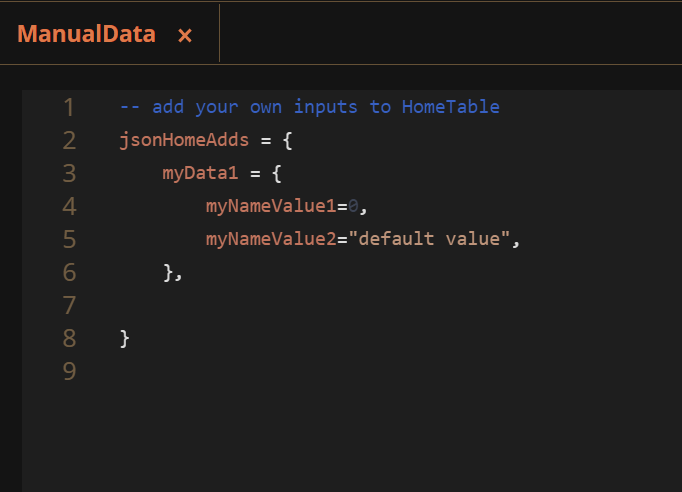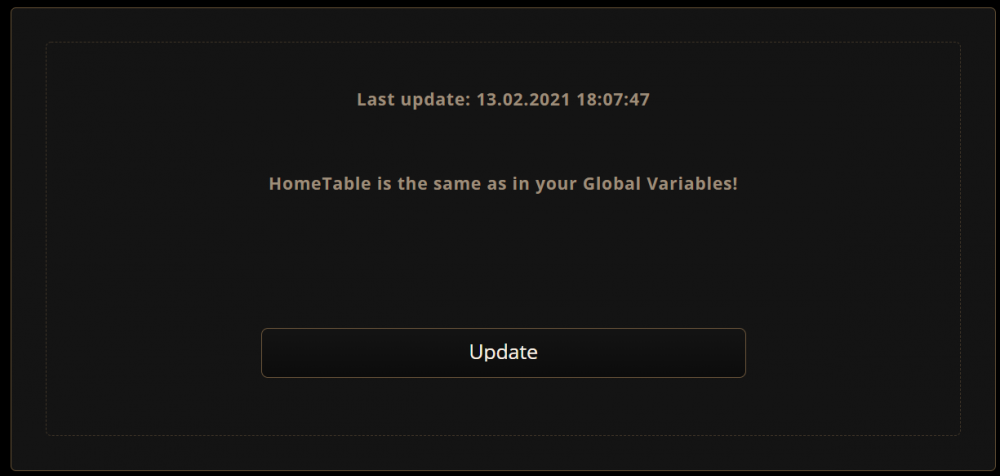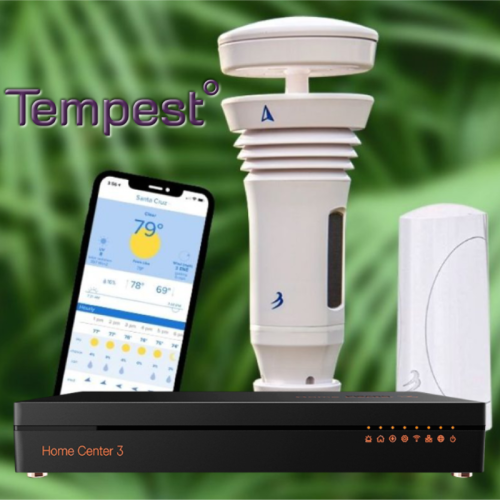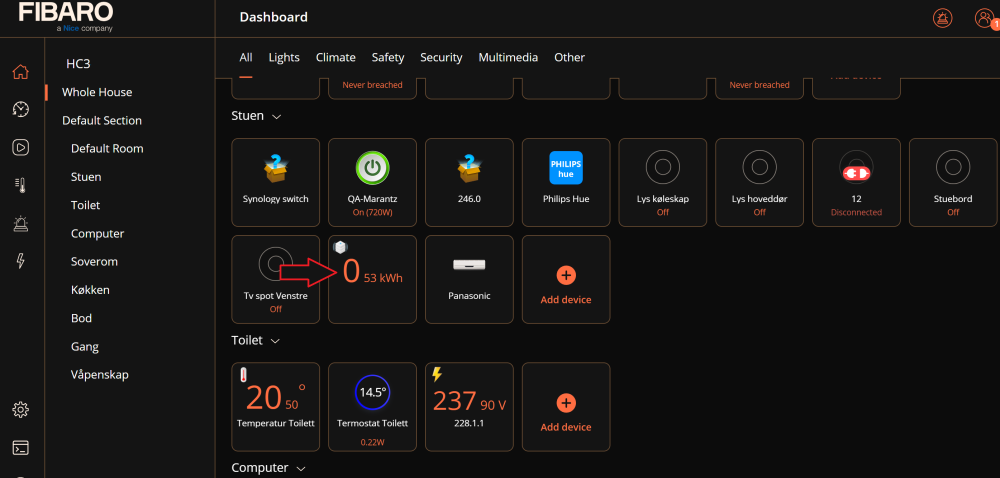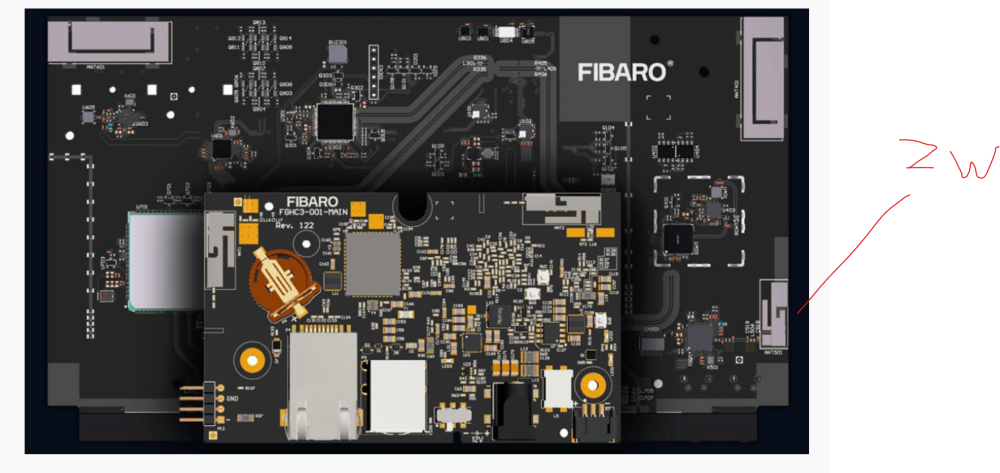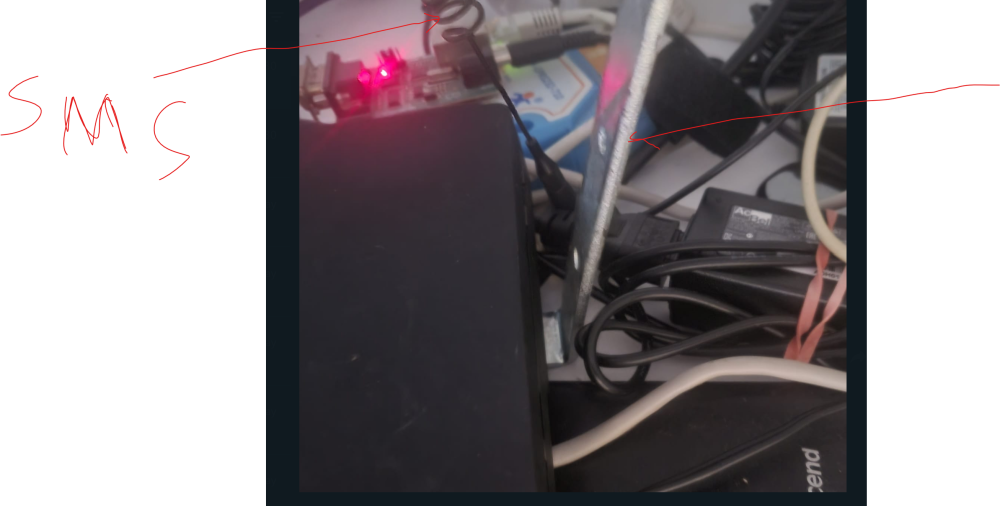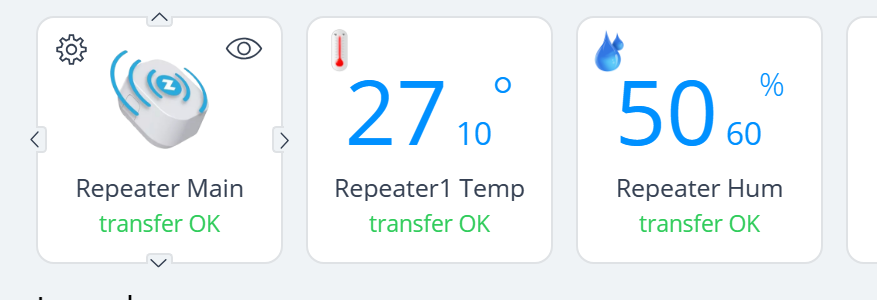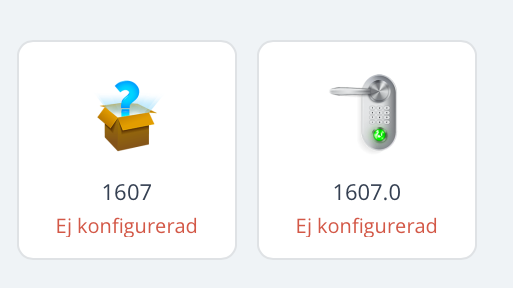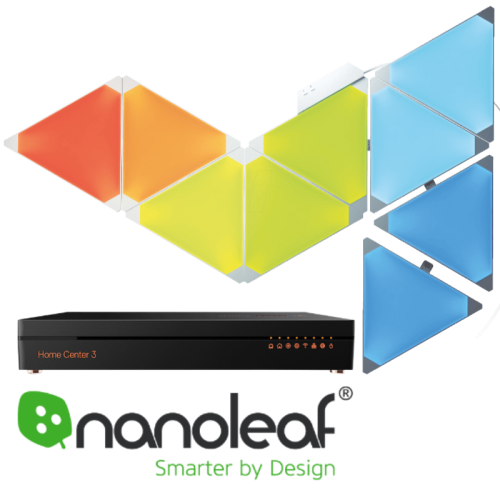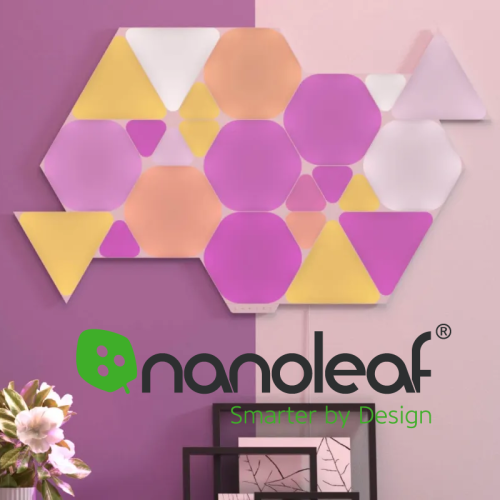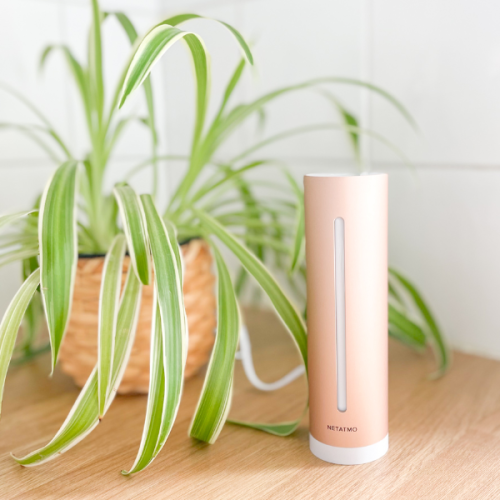Welcome to Smart Home Forum by FIBARO
Dear Guest,
as you can notice parts of Smart Home Forum by FIBARO is not available for you. You have to register in order to view all content and post in our community. Don't worry! Registration is a simple free process that requires minimal information for you to sign up. Become a part of of Smart Home Forum by FIBARO by creating an account.
As a member you can:
- Start new topics and reply to others
- Follow topics and users to get email updates
- Get your own profile page and make new friends
- Send personal messages
- ... and learn a lot about our system!
Regards,
Smart Home Forum by FIBARO Team
Search the Community
Showing results for tags 'hc3'.
-
QA for creating HomeTable in global variables in HC3. Why using hometable? Instalation: 1. upload this QA 2. In QA variables you can change name for hometable, name for scenes and time for regular update of hometable 3. In QA -> source files -> ManualData you can add your own data (it will be also saved in final hometable in global variables) How to read data from hometable: -- in case that your name for hometable is default=HomeTable local tbl = fibaro.getGlobalVariable("HomeTable") local HT = json.decode(tbl) -- structure for devices is <room>.<deviceName> local idQA_TV=HT.LivingRoom.TV -- structure for scenes is <ScenesName>.<sceneName> -- default value for <ScenesName> is Scenes local idSc_Lights=HT.Scenes.Lights -- structure for your own inputs from ManualData local myValue1=HT.myData1.myNameValue1 -- 0 local myValue2=HT.myData1.myNameValue2 -- "default value" Names for rooms, devices and scenes are corrected by following replaces: {["%."]="",["-"]="",["%("]="",["%)"]="",["&"]="",[":"]="",["%["]="",["%]"]="",["%+"]="",["%%"]="",["%/"]="",["%$"]=""} {["Á"]="A",["Ä"]="A",["Ą"]="A",["À"]="A",["Â"]="A",["Č"]="C",["Ć"]="C",["Ç"]="C",["Ď"]="D",["É"]="E",["Ě"]="E",["Ë"]="E",["Ę"]="E",["È"]="E",["Ê"]="E",["Í"]="I",["Ï"]="I",["Î"]="I",["Ĺ"]="L",["Ľ"]="L",["Ł"]="L",["Ň"]="N",["Ń"]="N",["Ó"]="O",["Ô"]="O",["Ö"]="O",["Ő"]="O",["Œ"]="O",["Ŕ"]="R",["Ř"]="R", ["Š"]="S",["Ś"]="S",["Ť"]="T",["Ú"]="U",["Ů"]="U",["Ü"]="U",["Ű"]="U",["Ù"]="U",["Û"]="U",["Ý"]="Y",["Ÿ"]="Y",["Ž"]="Z",["Ż"]="Z",["Ź"]="Z",["á"]="a",["ä"]="a",["ą"]="a",["à"]="a",["â"]="a",["č"]="c",["ć"]="c",["ç"]="c",["ď"]="d",["é"]="e",["ě"]="e",["ë"]="e",["ę"]="e",["è"]="e",["ê"]="e",["í"]="i",["ï"]="i",["î"]="i",["ĺ"]="l",["ľ"]="l",["ł"]="l",["ň"]="n",["ń"]="n",["ó"]="o",["ö"]="o",["ô"]="o",["ő"]="o",["œ"]="o",["ř"]="r",["ŕ"]="r",["š"]="s",["ś"]="s",["ť"]="t",["ú"]="u",["ů"]="u",["ü"]="u",["ű"]="u",["ù"]="u",["û"]="u",["ý"]="y",["ÿ"]="y",["ž"]="z",["ż"]="z",["ź"]="z"} Hometable in global variables will be overwrite only if newly generated hometable will be different. Version of QA HomeTable: 0.12 - 21.1.2021 HomeTable.fqa
-
Witajcie, Tygodnie na YouTube i wieczory na testach przeniosłem do mojego poradnika. Wrzucam instrukcję krok po kroku, jak zintegrować HC3 z Satel Integra 32. Celem jest nie tylko integracja Integra z HC3, ale stworzenie komunikacji, która pozwala na wykorzystanie manipulatora Satel do wyzwalania konkretnych scen w HC3. Stan na dzien Maj 2024. Konfiguracja centrali alarmowej SATEL i HC3.pdf
-
Cannot select a different Home Center to use with Alexa Integration
Ploudo posted a question in Amazon Alexa
Hi, I have multiple HomeCenters (2x HC3 and one HC2) in 3 different homes. Two of these homes are mine, but are in different geographical locations. I've created two seperate amazon accounts, both of which use alexa. The problem I'm facing is that when setting up the Yubii integration on Alexa, I don't have the opportunity to chose which HomeCenter I wish to use. This results in the devices of my main home being all added to my 2nd home (as these devices were previously added to the Alexa over there) and no way at all to ad the new HC3 and al of it's connected devices. This is particularly annoying as Fibaro (or Yubii now, idk) give you acces to multiple HomeCenters from home.fibaro.com/... . But I have no way to select any of these devices when setting up alexa with Yubii. Is there any way to specify WHICH home center to use when connecting Yubii to Alexa with the skill? Thanks for any help. -
A thread to share some coding techniques for QuickApps? Because QAs are "long running scenes" (they don't have to be loaded and restarted for every event) - it is actually worthwhile to build up a library of "nice to have" code and include them in QAs. Here is Fibaro's manual for QuickApps. Here is Fibaro's manual for creating QuickAppChild devices Here is Fibaro's manual for using MQTT client Here is Fibaro's manual for WebSocket client List of posts: Introduction to the QuickApp anatomy - tutorial Part 1. Lua functions and object-oriented programming. (QuickApp is a OO class, so we need that base) Part 2. The basic QuickApp functions and what they do... and how. Part 3. More on QuickApp event handling - interaction with the UI and fibaro.call(<quickApp>,"name",...) Part 4. QuickAppChildren and how to raise them... what makes them tick? Also a tutorial on using classes in QuickApps here... All functions and variables available in the QuickApp Lua environment Logging functions (replacement for color/html tags + tostring for customised data structure) Shared functions calls between QuickApps (Here is an improved version) Off-line HC3api to use fibaro.* calls on PCs/Linux/Mac (fibaroapiHC3.lua) Polling for triggers in a QuickApps (like fibaro.getSourceTrigger()) Here is another method using a helper QA Patching 'setTimeout' so you get an error message if the function crashes A generic template for a QuickApp A simple code-lock QuickApp (demonstrating the UI with buttons) A QuickApp for scheduling user profiles (demonstrates UI buttons that change labels/text to present options) It doesn't' actually schedules the profile yet. (here is a working version) Structuring a QuickApp using event handlers to cope with asynchronous calls - like when using net.HTTPClient() instead of FHTTP(). looping with setInterval (without drifting) A QD reporting if other QDs are crashing (leveraging the "polling for triggers" code) Coding and debugging HC3 QuickApps offline using PC/Mac/Linux and a Lua IDE (and auto-creating a proxy on the HC3) An example of a QuickApp that download and installs scenes and QuickApps from a repository (files in a flat format) Coding and debugging of HC3 scenes using fibaroapiHC3.lua (not strictly about QuickApps but related) - can speed-up time A more complex QD that reads Google calendars or iPhone calendars and schedule custom events (uses the QuickApp structure for asynchronous calls in a previous tip) A substitute for Lua's loadstring() Here is another method of loading code dynamically into a QA Creating proxy devices on the HC3 to share devices between HC2 and HC3 A "webhook" QD - pushing events to external apps Adding interfaces to QA's - ex. power and battery and updating the properties (updates the little battery and power icon UI) @tinman Using '/plugin/publishEvent' to emit 'centralSceneEvent' (and a few other) .... Ex. keyfob QA by @tinman QA Toolbox. A modular toolbox of add-on functions to QAs that makes it easier to develop QAs 'basic' - Generic QA functions for loggin, loading modules, and management - used by all other modules. (some documentation) 'childs' - QA functions to easily manage quickAppChild devices. Loading, saving state, getting UI events etc. 'events' - QA functions for defining event handlers and structuring your code accordingly. Makes it easy to setup timers in various ways... 'triggers' QA functions for recieving triggers like Scenes do. The events module will receive triggers if loaded, but own handler can be defined. 'rpc' - QA functions for declaring (synchronous) remote functions from other QAs files - QA functionality for copying files between QAs pubsub - QA functions for event publish/subscribe... ui - QA functions for manipulation the UI elements of a QA lua parser/compiler - QA function for emulating loadstring and evaluating Lua expression from strings profiler - Functions for timing code used in QA Reading label/button/slider values. Sha2.lib crypto libs for HC3 (MD5, HMAC, SHA-1, SHA-224, SHA-256, SHA-512/224, SHA-512/256, SHA-384, SHA-512, SHA3-224, SHA3-256, SHA3-384, SHA3-512, SHAKE128, SHAKE256) @tinman aes crypto lib @tinman List of HC3 device types and interfaces @tinman Readers note. I started to call QuickApp devices for QDs (as in QuickApp Device, thought QAs sounded like Question and Answers). So, I use the word QD here and there but I'm not religious about it...
-
Version 1.0
13 downloads
Tempest Weather Station QA v1.0 Standalone INTRODUCTION Tempest Weather station QA brings complete integration of Tempest weather station to HC3, HC3Lite and Yubii Home users. PREREQUISITES Fibaro HC3, HC3Lite or Yubii Home with firmware 5.150 or greater One or more Tempest Weather station FEATURES Complete integration of Tempest weather station with HC3, HC3Lite and Yubii Home Automatically changes measurement units and recalculates them when user change the units in the mobile app. After adding child QA by using button on main QA user can remove unwanted ones. Removed child QA can be added again. Has button for manually update QA. QA has built in multi-language support with 32 languages included. QA can use HC selected language or user can select any other available language. AVAILABLE DOWNLOAD Tempest Weather station QA v1.1 Standalone Tempest Weather station QA User manual v1.0EN TERMS AND CONDITIONS Permission to use, copy, modify and distribute this software and its documentation for educational, research, personal use and non-profit purposes, without fee and without a signed licensing agreement is hereby granted, provided that the copyright notice, with "Terms and conditions" and "Disclaimer" appear in all copies, modifications and distributions. It is strictly forbidden to sell, rent, lease and/or lend this software for profit without prior consent from the Author. DISCLAIMER This software is provided by copyright owner "as is" and any express or implied warranties, including, but not limited to, the implied warranties of merchantability and fitness for a particular purpose are disclaimed. In no event shall the author and distributor be liable for any direct, indirect, incidental, special, exemplary, or consequential damages (including, but not limited to, procurement of substitute goods or services; loss of use, data, or profits; or business interruption) however caused and on any theory of liability, whether in contract, strict liability, or tort (including negligence or otherwise) arising in any way out of the use of this software, even if advised of the possibility of such damage. Fibaro a Nice company and their employees are not responsible for support of this QA. Please contact the author Sankotronic, on the Fibaro Forum, for any questions or support required. VERSION HISTORY 1.0 - first public release as open source. LOOK & FEEL Enjoy coding and your new Tempest weather station QA! Sankotronic -
I red lots of feeds but I cant find one single, not complicate device wakeup script for HC3. Im not programmer but I can work with not complicated code.. I have this few lines from older threads in fibaro forum. I have something like this: --[[ %% autostart %% globals --]] fibaro:getvalue(107, ´dead´) to wake up: fibaro:call(107, "wakeupdeaddevice" OR fibaro:wakeUpDeadDevice(107, 1); But I cant go through.. shows error (load):1: Assertion failed: Expected number BUT HOW to get functional little script from these lines... THANK YOU very much for any idea.
-
I can't connect to HC3. FIBARO is no news about when the system will be back.
-
Hello I have searched but couldn't find anything about how to update the values in the home screen from a Quick app I have a app that have changing values(string) and would be nice to have that info also in the home screen. Not sure what these are called.
-
I had an issue with some Z-wave devices that insists to be disconnected from HC3. Have tried to relocate HC3 (as much as possible w/o irritating my wife) without success, always had some disconnected devices. But during the relocation have noticed that in some specific spot all devices have been connected. The problem to achieve full coverage, requires accuracy of ONE millimeter! Have tried to understand, why? I have my own SMS system connected to HC3 and when a specific corner of HC3 has touched the antenna (accidently) I have a good coverage. So.... I took a piece of metal and actually stuck it under HC3 like antenna (see below), now I have an excellent coverage. It's sound like a joke, but it's not a joke at all. After that have found an image of HC3 board, and YES, the Z-wave antenna is actually located on that corner of the box. Of course, will try to get a proper 868Mhz antenna to attach instead of current solution, but hey! it does the job. By the way did the same for Zigbee antenna also and again, a good improvement. There is a good logic behind that. Since HC3 has internal on-board printed antennas, any piece of metal could work as extender. Of course, it should be placed correctly otherwise it will cause interference. Let's say it's like wireless charging that we are using daily for our phones, as you know you should place the phone in very specific area. Here the actual image (please forgive me for the mess, the cost of moving the equipment around) In addition, I recommend using Z-wave repeater NEO Coolcam Z-Wave EU Repeater Sensor Compatible Zwave System 700 Series Home Automation - AliExpress It does work very well (not like AoenLabs extender which always shown as unconfigured device on all Fibaro systems). This extender configured and all parameters could be defined. Best repeater I ever had. I am very curios if it helps to others... please let me know if it works for you too.
- 22 replies
-
- 2
-

-
Dzień dobry. Być może coś źle robię, ale mimo usilnych starań nie udało mi się dodać żadnego urządzenia Zigbee do centrali HC3 podłączonej w trybie SLAVE. Na centrali MASTER - wszystko działa bez zarzutu. Slave - nie widzi zigbee. Może ktoś zna rozwiązanie tego problemu? Będę wdzięczny za pomoc.
-
Anybody having success updating motion sensor to 3.4 from 3.3 on HC3? My update is basically forever in this state. Of course I did manual wake up of the device, but still 0%. Any ideas where (some API) to look for more information?
-
I want to know how to integrate HC3 with Broadlink RM4 PRO? If anyone created Quick apps for Broadlink devices could you please share with me the details?
- 13 replies
-
- broadlink
- fibaro hc3
-
(and 1 more)
Tagged with:
-
I want to do some normal validation of the UI (normal for people other than Fibaro which doesn't seem to understand the finer things of the user interface concepts). My immediate desire is to take two values from the UI and pass them both to the API where they will be processed. The device is a thermostat and is using the com.fibaro.hvacSystemAuto device type. This presents the user a heating setpoint and a cooling setpoint when the thermostat is in Auto mode. But when the "Set" button is pressed, it sends the heat setpoint as an action, then it sends the cool setpoint. But the API expects both setpoints when the device is in Auto. Further, it burps if the heat setpoint is hotter than the cool setpoint. Even worse, the device control is in the cloud so the round trip is quite slow. It appears that the heat setpoint property I retrieve using fibaro.getValue(self.id, "heatingThermostatSetpoint") doesn't appear to be the value which was just sent (and passed to the cloud) during the heat setpoint onAction() method [remember, BOTH values are sent to the API on each call]. My original idea was to adjust the current setpoints so that the cooling setpoint was 2° higher than the heating setpoint when that setpoint is about to be set if they are not already in a valid state. Then, during the cooling setpoint adjustment, I would change the heating setpoint to be 2° cooler than the cooling setpoint if they are not already in a valid state. Of course an even better solution would be to be able to peek at the other setpoint in the UI and send it. And ideally, I would like to be able to keep the state of the two setpoints in a valid state at all times. The app used by the thermostat adjusts the heating down if the cooling setpoint is adjusted down too much or it adjusts the cooling up if the heating setpoint is adjusted up too much. So it would be good practice to do something similar in the Fibaro UI. 🙄 But that's not likely to happen anytime in my lifetime or my children's lifetimes either. The code I'm using is: elseif (self.properties.thermostatMode == "Auto") then self:debug('Original coolingThermostatSetpoint ' .. self.properties.coolingThermostatSetpoint) -- The coolingThermostatSetpoint must be greater than the heatingThermostatSetpoint. -- Since both the heating and cooling setpoints are updated individually but the -- API must be adjusted for both values at the same time, there are problems when -- the heating setpoint is hotter than the cooling setpoint. Solution (for now) is to -- adjust the coolingThermostatSetpoint to be 2° higher than the new heatingThermostatSetpoint. -- **Note: If the user has not set these two setpoints correctly, the actual heating and cooling -- setpoints will reflect a 2° difference from whichever setpoint has been called last. local coolValue = fibaro.getValue(self.id, 'coolingThermostatSetpoint') self:debug(string.format("getValue() returned %f", coolValue)) if coolValue <= roundedHeatValue then coolValue = roundedHeatValue + 2 end My first pass used the self.properties.coolingThermostatSetpoint value. Then I tried the call to fibaro.getValue() but that didn't seem to help either. The code to set the cooling setpoint is a duplicate of the above except the heating setpoint is adjust downward by 2 vs. the cooling setpoint being adjusted upward. So what am I doing wrong? Thanks in advance to any ideas or solutions. Peter PS: After working on this some more I FINALLY recognized this is a symptom of the async nature of web communication. Both setpoints are called back to back (duh). But the first call gets all the way to sending the API command out and then yields while that happens asynchronously. Then the other setpoint is changed and does the same thing. EXCEPT, the original heating setpoint has not been updated in the hub because that process is not executed until the success of the API call. I know how basic this is to people but I'm something of a dinosaur and cannot get it through my pea-sized, dinosaur brain that things have to happen asynchronously because of the latency of internet communications. Ok....now I'm back on board with all of this and I must find some elegant solution to resolve this. Forgive me for showing my ignorance but I learned a valuable lesson (again, but maybe it will stick this time).
-
I have an issue with removing a Danalock from my HC3. I first tried to reconfigure the lock but it does not reconfigure, this is weeks ago. When trying to remove the lock nothing happens. when I try to force delete the lock I get the following Z-Wave trace: ”ID 1607: NOP sending succeeded. The device has not been removed. Please use Learning Mode to remove it.” Is there any other way to delete the device?
-
Hello, I have climate shcedule problems with hc3. Now I use HC3 (now 5.140, had the same issue before with previous firmwares too), Heatit z-temp2 thermostat, fibaro relay module. My problem: I can clearly see that the issue is caused by the virtual device Thermostat& Heating zone (plugin used for manual mode). We use the heating in schedule mode, at every temperature change has the same strange thing. For example: From 4-6 pm we ask for 18 celsius, than 6-7pm we ask for 21 celsius, from 7pm again 18celsius. Now at 6pm every time the schedule mode sets the 21 celsius but immidiately after the manual mode turns on (without manually use, we do not touch the thermostat nor the application or anything for climate change) and gives again the 21 pm but with the plugin's parameter it stays for 4hours. So instead of 7pm 18 celsius the system stays on 21 for 3 more hours... Btw... I have so much trouble with HC3. The lights, scenes, heating. It has so many problems... With HC2 everything works just fine and HC3 I have issues from the beginning. I use it since about 6 months and had no sollution for many problems. Hope someone can help me, cause I need to solve this heating problem asap. Thank you!
- 5 replies
-
- manual mode
- hc3
-
(and 4 more)
Tagged with:
-
Czy ktoś może pomóc w wykonaniu QA? Potrzebne aby QA : - po naciśnięciu przycisku wykonało - "open" danego urządzenia - sprawdziło stan czujnika binarnego i zwróciło jego wartość w formie "otwarte" gdy true lub "zamknięte" gdy false - wpisało stan czujnika w etykiecie QA Przykład: function QuickApp:wjazd_open() -- nazwa przycisku QA hub.call(1955, "open") -- otwarcie bramy (smart implant zwiera styki) self:updateView("wjazd_label", "text", "Brama wjazdowa: " .. tostring(hub.getValue(152, "value")) ) -- 152 to czujnik otwarcia bramy end
-
Hi everyone, I have a lua scene that turns a light on when motion is detected and turns it off after 1 minute. How can I make it not turn the light off if it has been previously turned on manually using the switch? Here is the code for the scene { conditions = { { id = 220, isTrigger = true, operator = "==", property = "value", type = "device", value = true } }, operator = "all" } fibaro.call(185, 'turnOn') fibaro.setTimeout(60000, function() fibaro.call(185, 'turnOff') end) Thanks a lot
-
Version 1.1
98 downloads
Netatmo Weather Station QA standalone v1.1 INTRODUCTION Netatmo Weather station QA brings complete integration of Netatmo weather station to HC3, HC3Lite and Yubii Home users including rain and wind gauges and support for more than one station. PREREQUISITES Fibaro HC3, HC3Lite or Yubii Home with firmware 5.150 or greater One or more Netatmo Weather station FEATURES Complete integration of Netatmo weather station with HC3, HC3Lite and Yubii Home including rain gauge and anemometer Only one QA is needed for any number of Netatmo Weather stations and their included modules. Support for Netatmo weather station main module without outdoor module included Support for maximum 3 additional indoor modules per station Smart update system that follows Netatmo weather station cloud updates Netatmo weather station measurements are shown on child devices added for each measurement of all stations and their modules found QA has built in multi-language support with 32 languages included. QA can use HC selected language or user can select any other available language. AVAILABLE DOWNLOAD Netatmo Weather station QA v1.1 Netatmo Weather station QA User manual v1.1 TERMS AND CONDITIONS Permission to use, copy, modify and distribute this software and its documentation for educational, research, personal use and non-profit purposes, without fee and without a signed licensing agreement is hereby granted, provided that the copyright notice, with "Terms and conditions" and "Disclaimer" appear in all copies, modifications and distributions. It is strictly forbidden to sell, rent, lease and/or lend this software for profit without prior consent from the Author. DISCLAIMER This software is provided by copyright owner "as is" and any express or implied warranties, including, but not limited to, the implied warranties of merchantability and fitness for a particular purpose are disclaimed. In no event shall the author and distributor be liable for any direct, indirect, incidental, special, exemplary, or consequential damages (including, but not limited to, procurement of substitute goods or services; loss of use, data, or profits; or business interruption) however caused and on any theory of liability, whether in contract, strict liability, or tort (including negligence or otherwise) arising in any way out of the use of this software, even if advised of the possibility of such damage. Fibar Group S.A. and their employees are not responsible for support of this QA. Please contact the author Sankotronic, on the Fibaro Forum, for any questions or support required. VERSION HISTORY 1.1 - first public release as open source. LOOK & FEEL Enjoy coding and your new Netatmo weather station QA! Sankotronic- 2 comments
-
- 4
-

-
- sankotronic
- netatmo
-
(and 5 more)
Tagged with:
-
Version 1.0
19 downloads
Nanoleaf Aurora QA standalone v1.0 INTRODUCTION Nanoleaf Aurora QA brings complete integration of Nanoleaf Aurora light panels to HC3, HC3Lite and Yubii Home. PREREQUISITES Fibaro HC3, HC3Lite or Yubii Home with firmware 5.150 or greater Nanoleaf Aurora light panels FEATURES Enables HC3, HC3Lite and Yubii Home to control Nanoleaf Aurora lights and show their status Can control brightness, hue, saturation, color temperature and activate color effects QA automatically updates list of the available effects when added or deleted with Nanoleaf mobile application Has buttons for light effects selection and activation Selected and running effect type can be recognized by emoji icon in front of the of the effect name. If Nanoleaf Aurora light has attached Rhythm module this QA will recognize it and enable selection between built in microphone or AUX input. Rhythm module is automatically activated when rhythm effect is activated Has button for generating authorization token for easy connection to the Nanoleaf Aurora light QA has built in multi-language support with 32 languages included. QA can use HC selected language or user can select any other available language. AVAILABLE DOWNLOAD Nanoleaf Aurora QA v1.0 Nanoleaf Aurora QA User manual v1.0 TERMS AND CONDITIONS Permission to use, copy, modify and distribute this software and its documentation for educational, research, personal use and non-profit purposes, without fee and without a signed licensing agreement is hereby granted, provided that the copyright notice, with "Terms and conditions" and "Disclaimer" appear in all copies, modifications and distributions. It is strictly forbidden to sell, rent, lease and/or lend this software for profit without prior consent from the Author. DISCLAIMER This software is provided by copyright owner "as is" and any express or implied warranties, including, but not limited to, the implied warranties of merchantability and fitness for a particular purpose are disclaimed. In no event shall the author and distributor be liable for any direct, indirect, incidental, special, exemplary, or consequential damages (including, but not limited to, procurement of substitute goods or services; loss of use, data, or profits; or business interruption) however caused and on any theory of liability, whether in contract, strict liability, or tort (including negligence or otherwise) arising in any way out of the use of this software, even if advised of the possibility of such damage. Fibar Group S.A. and their employees are not responsible for support of this QA. Please contact the author Sankotronic, on the Fibaro Forum, for any questions or support required. VERSION HISTORY 1.0 - first public release as open source. LOOK & FEEL Enjoy coding and your new Nanoleaf Aurora QA! Sankotronic-
- 3
-

-

-
- sankotronic
- nanoleaf
-
(and 4 more)
Tagged with:
-
Version 1.0
20 downloads
Nanoleaf Shapes QA standalone v1.0 INTRODUCTION Nanoleaf Shapes QA brings complete integration of Nanoleaf Canvas, Shapes, Lines and Elements lights to HC3, HC3Lite and Yubii Home. PREREQUISITES Fibaro HC3, HC3Lite or Yubii Home with firmware 5.150 or greater Nanoleaf Canvas, Shapes, Lines or Elements light FEATURES Enables HC3, HC3Lite and Yubii Home to control Nanoleaf lights and show their status Can control brightness, hue, saturation, color temperature and activate color effects QA automatically updates list of the available effects when added or deleted with Nanoleaf mobile application Has buttons for light effects selection and activation Selected and running effect type can be recognized by emoji icon in front of the of the effect name. Nanoleaf Canvas, Shapes, Lines and Elements light control panel has built in Rhythm module and there is no AUX input available. Rhythm module is automatically activated when rhythm effect is activated Has button for generating authorization token for easy connection to the Nanoleaf light QA has built in multi-language support with 32 languages included. QA can use HC selected language or user can select any other available language. AVAILABLE DOWNLOAD Nanoleaf Shapes QA v1.0 Nanoleaf Shapes QA User manual v1.0 TERMS AND CONDITIONS Permission to use, copy, modify and distribute this software and its documentation for educational, research, personal use and non-profit purposes, without fee and without a signed licensing agreement is hereby granted, provided that the copyright notice, with "Terms and conditions" and "Disclaimer" appear in all copies, modifications and distributions. It is strictly forbidden to sell, rent, lease and/or lend this software for profit without prior consent from the Author. DISCLAIMER This software is provided by copyright owner "as is" and any express or implied warranties, including, but not limited to, the implied warranties of merchantability and fitness for a particular purpose are disclaimed. In no event shall the author and distributor be liable for any direct, indirect, incidental, special, exemplary, or consequential damages (including, but not limited to, procurement of substitute goods or services; loss of use, data, or profits; or business interruption) however caused and on any theory of liability, whether in contract, strict liability, or tort (including negligence or otherwise) arising in any way out of the use of this software, even if advised of the possibility of such damage. Fibar Group S.A. and their employees are not responsible for support of this QA. Please contact the author Sankotronic, on the Fibaro Forum, for any questions or support required. VERSION HISTORY 1.0 - first public release as open source. LOOK & FEEL Enjoy coding and your new Nanoleaf Shapes QA! Sankotronic-
- 3
-

-
- sankotronic
- nanoleaf
-
(and 4 more)
Tagged with:
-
Version 1.1
53 downloads
Netatmo Indoor Air Quality Monitor QA standalone v1.1 INTRODUCTION Netatmo Indoor Air Quality Monitor QA brings complete integration of Netatmo Indoor Air Quality Monitor (coach) to HC3, HC3Lite and Yubii Home users with support for more than one monitor. PREREQUISITES Fibaro HC3, HC3Lite or Yubii Home with firmware 5.150 or greater One or more Netatmo Indoor Air Care Monitor (coach) FEATURES Complete integration of Netatmo Indoor Air Quality Monitor(s) Only one QA is needed for multiple Netatmo Indoor Air Quality Monitors Smart update system that follows Netatmo Indoor Air Quality Monitors cloud updates Netatmo Indoor Air Quality Monitor measurements are shown on child devices added for each measurement of all monitors QA has built in multi-language support with 32 languages included. QA can use HC selected language or user can select any other available language. AVAILABLE DOWNLOAD Netatmo Indoor Air Quality Monitor QA v1.1 Netatmo Indoor Air Quality Monitor QA User manual v1.1 TERMS AND CONDITIONS Permission to use, copy, modify and distribute this software and its documentation for educational, research, personal use and non-profit purposes, without fee and without a signed licensing agreement is hereby granted, provided that the copyright notice, with "Terms and conditions" and "Disclaimer" appear in all copies, modifications and distributions. It is strictly forbidden to sell, rent, lease and/or lend this software for profit without prior consent from the Author. DISCLAIMER This software is provided by copyright owner "as is" and any express or implied warranties, including, but not limited to, the implied warranties of merchantability and fitness for a particular purpose are disclaimed. In no event shall the author and distributor be liable for any direct, indirect, incidental, special, exemplary, or consequential damages (including, but not limited to, procurement of substitute goods or services; loss of use, data, or profits; or business interruption) however caused and on any theory of liability, whether in contract, strict liability, or tort (including negligence or otherwise) arising in any way out of the use of this software, even if advised of the possibility of such damage. Fibar Group S.A. and their employees are not responsible for support of this QA. Please contact the author Sankotronic, on the Fibaro Forum, for any questions or support required. VERSION HISTORY 1.1 - first public release as open source. LOOK & FEEL Enjoy coding and your new Netatmo Indoor Air Care Monitor QA! Sankotronic-
- sankotronic
- coach
-
(and 5 more)
Tagged with:
-
How to include existing Devices in S2, without Packaging?
Joystick posted a question in Home Center 3
Hi all I have the issue to include my existing devices in S2 Mode, but because most of the capable devices are 1-2 years old I do not have the packaging/info anymore. Is there a way to do this in some way? cheers joystick -
Hi, I'm trying to configure ZXT-600 with my HC3 but I have some challenges/bugs. *Disclaimer - at this moment I'dont want to use any specific AC. I'm doing this as a "dry run" before final installation 1. HC3 without any problem recognize ZXT-600 "devices". ZXT-600 is wotking wit USB power adaptor. 2. I'm trying to configure ZXT-600 based on manual (https://1d7d2411-2e94-4f8c-a95f-87afc2c677d4.filesusr.com/ugd/6dacfa_70e9d19869b44299b27f501fd1673f85.pdf) . At the beginning I added two parameters: - 27 [Set IR Code number from built-in code library 27 (0x1B)] - I choose one of the Mitsubishi - 30 [Set Auto Report Condition Trigger By Room Temperature change 30 (0x1E)] - I choose value what menas based on manual "Auto report if room temperature is different from last report. 1(0x01) = 1°F (0.5°C)" ZXT-600 has been assigned to room Kuchnia/Kitchen (details on below print screen) I used iOS Fibaro application for HC3 and it looks that HC3/ZXT-600 doesn't work ijn proper way. 1. Even when I'm using parameter "Auto report if room temperature is different from last report. 1(0x01) = 1°F (0.5°C)" temperature doesn't change. Mobile application and Fibaro HC3 dashboard present one value (updated during power adaptor has been detached/attached) Is it a bug, malfunction or my lack of knowledge how to configure devices ? 2. I assume that should be possible send IR commnad (on, off, cooling, heating ...) from mobile application->HC3->ZXT-600 to air condition IR receiver. Maybe I'm wrong or I miss something. Unfortunatelly I haven't or I can't see any places in mobile/web applications where I could be do this Please let me know about your thoughts/experience. Thank you
-
HC3 not visible in network - How to factory reset without User Interface?
GdB posted a question in Home Center 3
Hello, After a parameter change of a MultiSensor the 'busy indicator' kept circling without saving parameters so I rebooted the HC3. After the reboot all Leds on the front of the HC3 are solid copper except for the Security LED that is blinking. After that manual reboot my HC3 is not visible anymore in software. Nowhere. - Not in the Fibaro Finder - Not in the DHCP Client list of my Router - In the Fibaro Remote Acces website ( https://dom.fibaro.com/cmh/home-center/list) it is visible but in Red with a red cross icon. - In the HC3 configuration interface (COMPONENTS.DEVICE-LIST.MAIN-HEADER.LOCAL-LIST) nothing appears (icon keeps rotating). The procedures in the manual are not clear for me: -1- Using the (+) Recovery button it says "Put in Recovery mode". I did this but how can I see/know it is in recovery mode when I have no User Interface? -2- Hold for xx seconds when network-icon and wif-icon are blinking = they never blink except during startup. They also do not blink after holding the (+) button for 20 s. This means I do not get a change to reset the network settings or switch between Dynamic and static IP. Because the IP address stays invisble I can not find a way to do a factory reset because I have no User Interface. Can someone help me to get my HC3 up and running again? How can I factory reset the HC3 when I have no interface at all? Thank you in advance for your support.- 6 replies
-
- factory reset
- no ip
-
(and 3 more)
Tagged with:
-
Hi there, recently updated to a HC3 and would like to add 2 Deye inverter to the energy panel. I did my research, but no idea how to implent it. Inverters are accesible via http://username.password@IP/status.html. Any idea and help would be great! Regards Francisco


